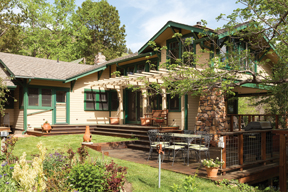Homes of All Stripes
19 Jan 2014
When this builder discovered the design preferences of many refugee and immigrant homebuyers, it changed the way he built homes.
In 1992, a talented and ambitious builder named Fernando Pagés Ruiz moved from Los Angeles to Lincoln, Neb. Knowing it was the site of one of the country’s Refugee Resettlement Programs, he embarked on a mission to build affordable starter homes for settlers from other parts of the world. Although the neighborhood he developed there, called Liberty Village, was later recognized with an Innovation in Workforce Housing Award from the National Association of Home Builders, it wasn’t an easy project for Pagés—at least not in the beginning.
“The homes just weren’t selling at first,” Pagés recalls. “I even hired a Vietnamese real estate agent to help with selling to refugees from Vietnam. I couldn’t understand it; they were good houses at a good price.”
Eventually, though, the houses did start selling, and Pagés was so surprised that he was compelled to ask the agent, Andy Vu, about the possible reasons for the sudden turnaround. In response, Vu invited Pagés with him to visit some homeowners in their new house.
“I was so surprised when I walked in,” says Pagés, “because the open floor plan I was so proud of was gone. They had completely closed up the kitchen and put in a door, separating it from the rest of the house. My first thought was, ‘These people ruined my house!’”
That’s when Vu had to come clean. Turns out, he had begun offering potential buyers a remodeling option that could be completed before they moved in. Why?
“Because the Vietnamese are used to closed kitchens,” Pagés explains. “They use a lot of fish sauce in their cooking, and they’re used to having ventilation to the outside, and often, their kitchens are even in the garage or outdoors. To them, having a kitchen basically in the living room or family room is weird, kind of like if houses here had a toilet in the living room. So those houses, as I’d built them, were actually impossible for them to live in.”
After that meeting, it dawned on Pagés that he should have known better—he’d actually had a similar experience with some homes he’d built in the 1980s in Los Angeles for Mexican immigrants.
“They’d buy these houses and then immediately remodel,” he recalls. “They wanted a courtyard-type front yard where they could interact, with a tall wall and a substantial gate, similar to plazas in Mexico. They also ripped out the carpet and put down tile.”
With two similar experiences under his belt, Pagés came to a very smart conclusion: “Something is wrong if they’re remodeling the day they move into a brand-new home. So why not just build what they want to start with?”
Although the neighborhood he developed there, called Liberty Village, was later recognized with an Innovation in Workforce Housing Award from the National Association of Home Builders, it wasn’t an easy project for Pagés—at least not in the beginning.
“The homes just weren’t selling at first,” Pagés recalls. “I even hired a Vietnamese real estate agent to help with selling to refugees from Vietnam. I couldn’t understand it; they were good houses at a good price.”
Eventually, though, the houses did start selling, and Pagés was so surprised that he was compelled to ask the agent, Andy Vu, about the possible reasons for the sudden turnaround. In response, Vu invited Pagés with him to visit some homeowners in their new house.
“I was so surprised when I walked in,” says Pagés, “because the open floor plan I was so proud of was gone. They had completely closed up the kitchen and put in a door, separating it from the rest of the house. My first thought was, ‘These people ruined my house!’”
That’s when Vu had to come clean. Turns out, he had begun offering potential buyers a remodeling option that could be completed before they moved in. Why?
“Because the Vietnamese are used to closed kitchens,” Pagés explains. “They use a lot of fish sauce in their cooking, and they’re used to having ventilation to the outside, and often, their kitchens are even in the garage or outdoors. To them, having a kitchen basically in the living room or family room is weird, kind of like if houses here had a toilet in the living room. So those houses, as I’d built them, were actually impossible for them to live in.”
After that meeting, it dawned on Pagés that he should have known better—he’d actually had a similar experience with some homes he’d built in the 1980s in Los Angeles for Mexican immigrants.
“They’d buy these houses and then immediately remodel,” he recalls. “They wanted a courtyard-type front yard where they could interact, with a tall wall and a substantial gate, similar to plazas in Mexico. They also ripped out the carpet and put down tile.”
With two similar experiences under his belt, Pagés came to a very smart conclusion: “Something is wrong if they’re remodeling the day they move into a brand-new home. So why not just build what they want to start with?”












